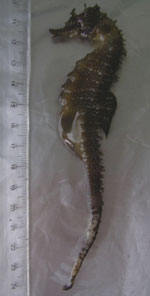Volume 17, Number 9—September 2011
Letter
Novel Mycobacterium Species in Seahorses with Tail Rot
To the Editor: Seahorses (Hippocampus guttulatus and H. hippocampus) with signs of tail rot disease (lethargy, lack of appetite, white spots on the skin, and necrotic tail lesions) were collected from aquaria at the Institute of Marine Research, Spain, during March 2007 through May 2009 (Figure A1). Microscopic examination of cutaneous lesions after Ziehl-Neelsen staining disclosed acid-fast bacilli. Microbiologic analysis showed unidentified Mycobacterium strains. Subsequently, we used PCR amplification of repetitive bacterial DNA elements to group the strains (1). The results showed an identical PCR pattern for the strains; thus, we selected strain BFLP-6T for analysis. On the basis of phenotypic and genotypic data, we consider the unknown acid-fast bacillus to represent a novel species of the genus Mycobacterium, for which the name M. hippocampi sp. nov. is proposed.
Extraction and amplification of genomic DNA for 16S rRNA sequence analysis were conducted as described (2), and the RNA polymerase B (rpoB) gene was amplified and sequenced as described by Adékambi et al. (3). Sequences obtained were compared against the sequences available in the GenBank, EMBL, and DDBJ databases obtained from the National Center for Biotechnology Information by using the BLAST program (4). Phylogenetic analysis were performed by using MEGA version 4.0 (5) after multiple alignments of data by ClustalX (6). Distances (distance options according to the Kimura 2-parameter model) and clustering with the neighbor-joining method were determined by using bootstrap values for 1,000 replications.
The 16S rRNA sequence of strain BFLP-6T was a continuous stretch of 1,473 bp (GenBank accession no. FN430736). Sequence similarity calculations after a neighbor-joining analysis indicated that the closest relatives of strain BFLP-6T were M. flavescens (98.26%), M. goodii (98.01%), M. duvalii (97.94%), M. smegmatis (97.92%), and M. novocastrense (97.86%) (Figure). Similar results were obtained for strain BFLP-6T when the maximum-parsimony algorithm was used. The rpoB gene has also been proposed as a useful marker for inferring bacterial phylogeny (7,8). A pair-wise analysis of the rpoB sequence of strain BFLP-6T (GenBank accession no. FR775976) showed low levels of similarity (<89.8%) with other species of the genus Mycobacterium. The G + C content of DNA, as measured by the thermal denaturation method, was 66.7 mol%.
Strain BFLP-6T was found to consist of gram-positive–staining, aerobic, acid-alcohol–fast, nonmotile, and nonsporulating cells. A scanning electron micrograph showed that strain BFLP-6T is irregular, rod-shaped, ≈1.2–1.4 μm in length, and 0.4 μm in diameter. Colonies on Lowenstein-Jensen medium supplemented with 1.5% (wt/vol) sodium chloride were orange after incubation at 25°C for 5 days. The colonies were positive for catalase, glucose fermentation, arginine dihydrolase, urease, and aesculin, and assimilation of glucose, mannitol, potassium gluconate, and malate. The colonies were negative for nitrate reduction to nitrite, oxidase, indole production, gelatin hydrolysis, N-acetyl-
In addition, strain BFLP-6T showed resistance to isoniazid, thiophene-2-carboxylic hydrazide, hydroxylamine, thiacetazone, and picrate. However, the strain exhibited susceptibility to ciprofloxacin, clarithromycin, and rifampin. The type strain BFLP-6T has been deposited in the German Collection of Microorganisms and Cell Cultures, under reference DSM 45391T; and in the Belgian Coordinated Collections of Microorganisms under reference LMG 25372T.
Acknowledgments
We thank P. Quintas, A. Chamorro, M. Cueto, S. Otero, and P. Ruiz for skillful technical assistance.
This study was supported by the Spanish Ministry of Science and Technology (Hippocampus CGL2005-05927-C03-01 and Hipporearing CGL2009-08386). J.L.B. was supported by a postdoctoral I3P contract from the Spanish Council for Scientific Research.
References
- Balcázar JL, Gallo-Bueno A, Planas M, Pintado J. Isolation of Vibrio alginolyticus and Vibrio splendidus from captive-bred seahorses with disease symptoms. Antonie van Leeuwenhoek. 2010;97:207–10. DOIPubMedGoogle Scholar
- Balcázar JL, Pintado J, Planas M. Bacillus galliciensis sp. nov., isolated from faeces of wild seahorses (Hippocampus guttulatus). Int J Syst Evol Microbiol. 2010;60:892–5. DOIPubMedGoogle Scholar
- Adékambi T, Colson P, Drancourt M. rpoB-based identification of nonpigmented and late-pigmenting rapidly growing mycobacteria. J Clin Microbiol. 2003;41:5699–708. DOIPubMedGoogle Scholar
- Altschul SF, Gish W, Miller W, Myers EW, Lipman DJ. Basic local alignment search tool. J Mol Biol. 1990;215:403–10.PubMedGoogle Scholar
- Tamura K, Dudley J, Nei M, Kumar S. MEGA4: Molecular Evolutionary Genetics Analysis (MEGA) software version 4.0. Mol Biol Evol. 2007;24:1596–9. DOIPubMedGoogle Scholar
- Thompson JD, Gibson TJ, Plewniak F, Jeanmougin F, Higgins DG. The CLUSTAL_X windows interface: flexible strategies for multiple sequence alignment aided by quality analysis tools. Nucleic Acids Res. 1997;25:4876–82. DOIPubMedGoogle Scholar
- Case RJ, Boucher Y, Dahllöf I, Holmström C, Doolittle WF, Kjelleberg S. Use of 16S rRNA and rpoB genes as molecular markers for microbial ecology studies. Appl Environ Microbiol. 2007;73:278–88. DOIPubMedGoogle Scholar
- Adékambi T, Drancourt M, Raoult D. The rpoB gene as a tool for clinical microbiologists. Trends Microbiol. 2009;17:37–45. DOIPubMedGoogle Scholar
Figures
Cite This ArticleRelated Links
Table of Contents – Volume 17, Number 9—September 2011
| EID Search Options |
|---|
|
|
|
|
|
|

Please use the form below to submit correspondence to the authors or contact them at the following address:
José Luis Balcázar, Catalan Institute for Water Research,Emili Grahit 101, Girona 17003, Spain
Top